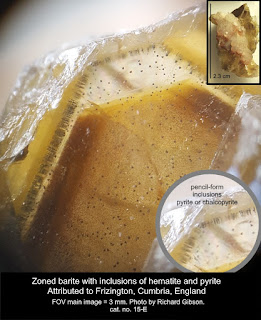Beginning with this post, the blog is "blog only" - no more podcasts, at least not for now.
The brownest zones of barite in this example result from dense inclusions of deep reddish material, probably hematite, in blebs smaller than a hundredth of a millimeter barely visible in the image. The larger inclusions you can see here are brassy spheres, triangular prisms, and elongate pencils, and are probably pyrite but chalcopyrite is possible. The lower right inset shows the pencil forms a little better than the main image.
The upper right inset is the entire 2.3-cm specimen. I don’t have a locality, but I attribute it to Frizington, Cumbria, England, because of the barite forms and inclusions, the associated white calcite (colored pink in places by hematite), and the presence of a few tiny hematite blades on the surface.
Zoning in crystals results from changes in the environment while the crystal is growing. In this case there were variations in the iron (and maybe copper, if some of the inclusions are chalcopyrite) content in what was otherwise a solution dominated by barium and sulfur (barite is barium sulfate).
Zoned crystals are common, although this one is kind of dramatic and I think the pencil-like inclusions, standing in ranks perpendicular to the crystal faces, are unusually weird and cool. It would be more difficult for such things to form than for a barite crystal surface to be coated with something and then have more barite deposited over that coating.
—Richard I. Gibson

No comments:
Post a Comment